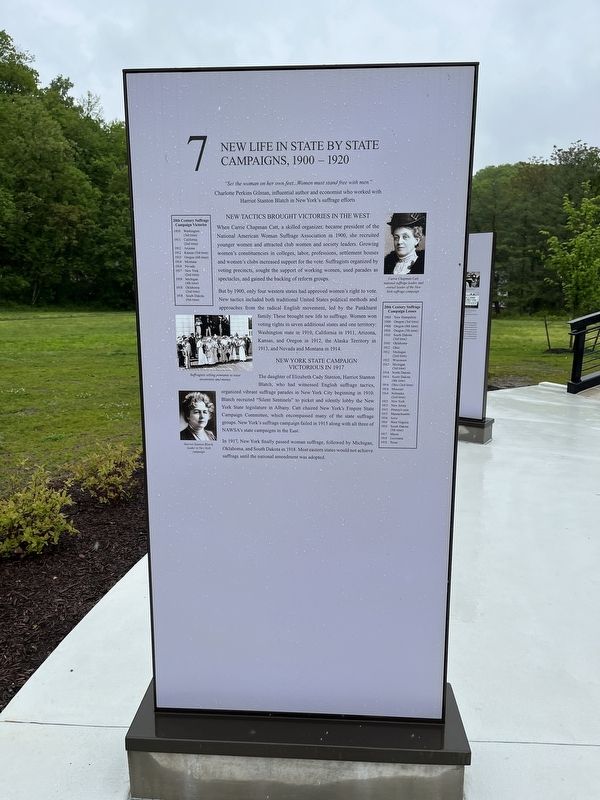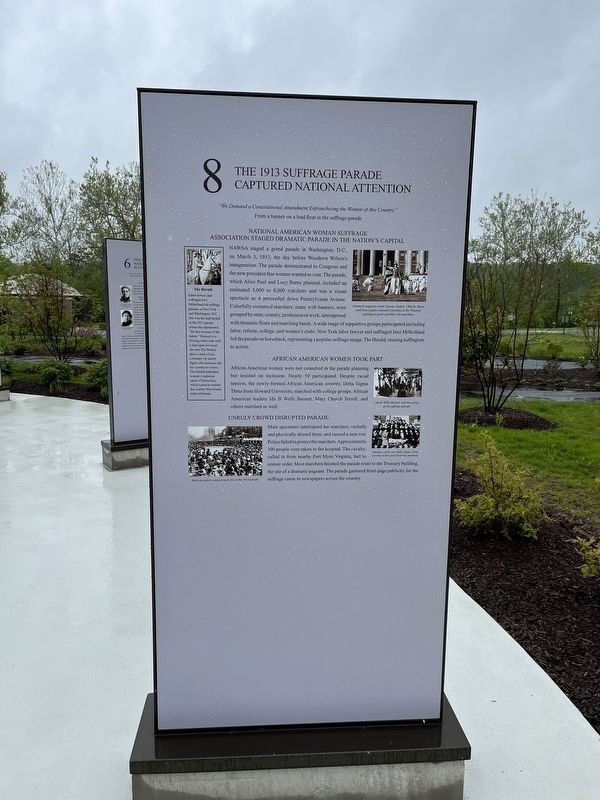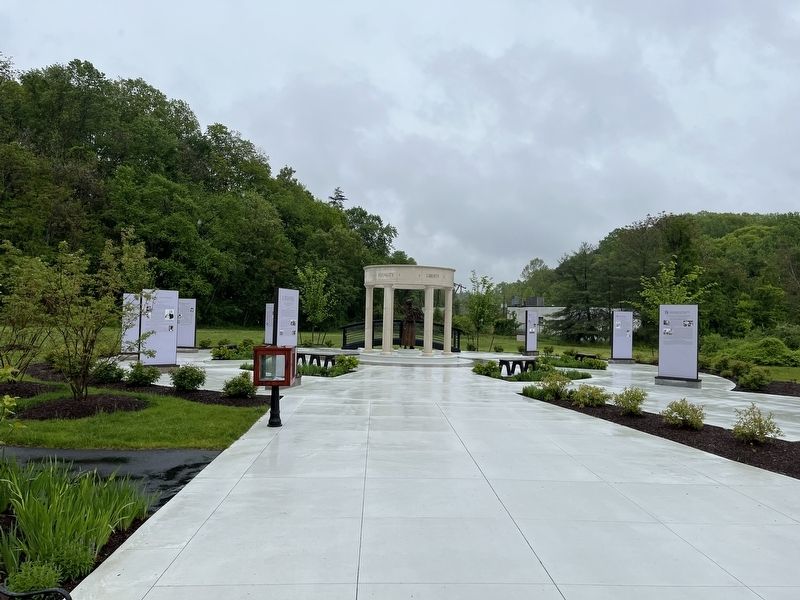Lorton in Fairfax County, Virginia — The American South (Mid-Atlantic)
New Life in State by State Campaigns / The 1913 Suffrage Parade Captured National Attention

Photographed By Devry Becker Jones (CC0), May 6, 2022
1. New Life in State by State Campaigns side of marker
New Life in State by State Campaigns, 1900-1920
"Set the woman on her own feet…Women must stand free with men."
Charlotte Perkins Gilman, influential author and economist who worked with Harriot Stanton Blatch in New York's suffrage efforts
New Tactics Brought Victories in the West
When Carrie Chapman Catt, a skilled organizer, became president of the National American Woman Suffrage Association in 1900, she recruited younger women and attracted club women and society leaders. Growing women's constituencies in colleges, labor, professions, settlement houses and women's clubs increased support for the vote. Suffragists organized by voting precincts, sought the support of working women, used parades as spectacles, and gained the backing of reform groups.
But by 1900, only four western states had approved women's right to vote. New tactics included both traditional United States political methods and approaches from the radical English movement, led by the Pankhurst family. These brought new life to suffrage. Women won voting rights in seven additional states and one territory: Washington state in 1910, California in 1911, Arizona, Kansas and Oregon in 1912, the Alaska Territory in 1913, and Nevada and Montana in 1914.
New York State Campaign Victorious in 1917
The daughter of Elizabeth Cady Stanton, Harriot Stanton Blatch, who had witnessed English suffrage tactics organized vibrant suffrage parades in New York City beginning in 1910. Blatch recruited "Silent Sentinels" to picket and silently lobby the New York State legislature in Albany. Catt chaired New York's Empire State Campaign Committee, which encompassed many of the state suffrage groups. New York's suffrage campaign failed in 1915 along with all three of NAWSA's state campaigns in the East.
In 1917, New York finally passed woman suffrage, followed by Michigan, Oklahoma, and South Dakota in 1918. Most eastern states would not achieve suffrage until the national amendment was adopted.
[Timelines:]
20th Century Suffrage Campaign Victories
1910: Washington (3rd time)
1911: California (2nd time)
1912: Arizona
1912: Kansas (3rd time)
1912: Oregon (6th time)
1914: Montana
1914: Nevada
1917: New York (2nd time)
1918: Michigan (4th time)
1918: Oklahoma (2nd time)
1918: South Dakota (6th time)
20th Century Suffrage Campaign Losses
1903: New Hampshire
1906: Oregon (3rd time)
1908: Oregon (4th time)
1910: Oregon (5th time)
1910:South Dakota (3rd time)Photographed By Devry Becker Jones (CC0), May 6, 20222. The 1913 Suffrage Parade Captured National Attention side of the marker
1910: Oklahoma
1912: Ohio
1912: Michigan (2nd time)
1912: Wisconsin
1913: Michigan (3rd time)
1914: North Dakota
1914: South Dakota (4th time)
1914: Ohio (2nd time)
1914: Missouri
1914: Nebraska (2nd time)
1915: New York
1915: New Jersey
1915: Pennsylvania
1915: Massachusetts
1916: Iowa
1916: West Virginia
1916: South Dakota (5th time)
1917: Maine
1918: Louisiana
1919: Texas
[Captions:]
Suffragists selling pennants to raise awareness and money.
Harriot Stanton Blatch, leader in New York campaign.
Carrie Chapman Catt, national suffrage leader, and overall leader of the New York suffrage campaign.
The 1913 Suffrage Parade Captured National Attention
"We Demand a Constitutional Amendment Enfranchising the Women of this Country."
From a banner on a lead float in the suffrage parade
National American Woman Suffrage Associations Staged Dramatic Parade in the Nation's Capital
NAWSA staged a grand parade in Washington, D.C., on March 3, 1913, the day before Woodrow Wilson's
African American Women Took Part
African American women were not consulted in the parade planning but insisted on inclusion. Nearly 50 participated. Despite racial tension, the newly-formed AFrican American sorority, Delta Sigma Theta from Howard University, marched with college groups. African American leaders Ida B. Wells Barnett, Mary Church Terrell, and others marched as well.
Unruly Crowd Disrupted Parade
Male spectators interrupted the marchers, verbally and physically abused them, and caused a near riot. Police failed to protect the marchers. Approximately 100 people were taken to the hospital. The cavalry, called in from nearby Fort Myer, Virginia, had to restore order. Most marchers finished the parade route to the Treasury building, the site of a dramatic pageant. The parade garnered front-page publicity for the suffrage cause in newspapers across the country.
[Sidebar:]
The Herald
Labor lawyer and suffragist Inez Milholland led suffrage parades in New York and Washington, D.C. She was the lead herald in the 1913 parade where she represented "the free woman of the future." Dressed in a flowing white robe with a tiara above her head, she was The Herald, akin to Joan of Arc, a militant yet saintly figure who had once led her country to victory. The Herald embodied women's righteous cause of democracy, which aimed to redeem the country from biased male politicians.
[Captions:]
Dramatic pageant where Liberty, Justice, Charity, Hope, and Peace gather around Columbia at the Treasury building to greet and bless the marchers.
Ida B. Wells Barnett with her group at the suffrage parade.
Members of the new Delta Sigma Theta sorority at Howard University marched.
Male spectators cause a near riot at the 1913 parade.
Erected 2021 by Turning Point Suffragist Memorial Association. (Marker Number 7/8.)
Topics and series. This historical marker is listed in these topic lists: African Americans • Civil Rights • Education • Notable Events • Women. In addition, it is included in the Former U.S. Presidents: #28 Woodrow Wilson, the Historically Black Colleges and Universities, and the Mary Church Terrell series lists. A significant historical date for this entry is March 3, 1913.
Location. 38° 40.938′ N, 77° 15.175′ W. Marker is in Lorton, Virginia, in Fairfax County. Marker is on Lorton Road, one mile south of Ox Road (Virginia Route 123), on the left when traveling east. Touch for map. Marker is at or near this postal address: 9751 Ox Rd, Lorton VA 22079, United States of America. Touch for directions.
Other nearby markers. At least 8 other markers are within walking distance of this marker. Suffrage Campaigns State By State / New Leaders, New Approaches (here, next to this marker); 1916 / Nonviolent Protests at the White House Gates (here, next to this marker); Building a Political Movement / Testing Constitutional Amendments (a few steps from this marker); "Forward Out of Darkness" / Issuing a Call for Women's Rights (a few steps from this marker); The Suffrage Campaign in Wartime / Suffrage Pickets Chose Prison (a few steps from this marker); Worsening Conditions / Violent Repression (a few steps from this marker); Hard-Fought Ratification Campaigns in the States / The Continued Struggle for Voting Rights (a few steps from this marker); Victories in 1917 / Suffragists Demonstrated Until Congress Passed the 19th Amendment (a few steps from this marker). Touch for a list and map of all markers in Lorton.
Additional keywords. universal suffrage; physical assault; incels; violence and intimidation
Credits. This page was last revised on November 6, 2023. It was originally submitted on May 7, 2022, by Devry Becker Jones of Washington, District of Columbia. This page has been viewed 188 times since then and 35 times this year. Photos: 1, 2. submitted on May 7, 2022, by Devry Becker Jones of Washington, District of Columbia. 3. submitted on May 6, 2022, by Devry Becker Jones of Washington, District of Columbia.

